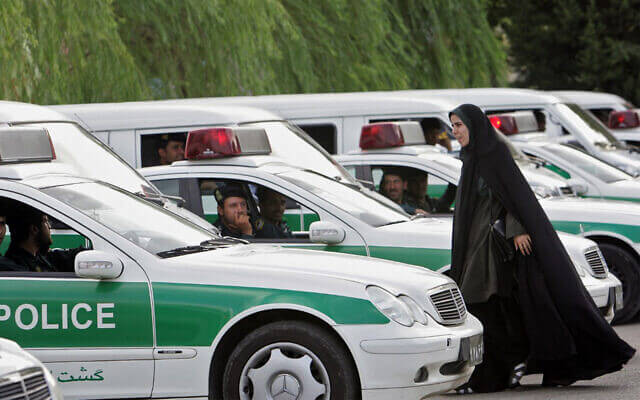After months of violent anti-government protests, Iranian Chief Prosecutor Mohammad Jafar Montazeri on Saturday announced the abolishment of the morality police, responsible for enforcing the Islamic dress code, and said authorities are also considering ending the hijab mandate.
Iranian media quoted Montazeri as saying that authorities had disbanded morality police in response to a question on whether authorities had shut down the religious police. However, he did not elaborate on his remarks, and the Iranian Interior Ministry, which is in charge of the morality police, has not confirmed Montazeri’s comments.
Iranian media have described Montazeri’s remarks as a “retreat” by Tehran regarding its stance on the hijab mandate owing to the persistence of nationwide protests but have cautioned that the judiciary has no say over the functions of the morality police.
2. As in any authoritarian context, appeasement of its opposition is being used as a survival strategy. But after 3 months of violently beating, raping, imprisoning & killing protesters,concessions in the form of promising to abolish the morality police are too little too late.
— Nazanin Boniadi (@NazaninBoniadi) December 4, 2022
On Friday, Montazeri said the Islamic Republic is considering ending the compulsory hijab laws, claiming that both the parliament and the judiciary are discussing whether changing the law forcing women to cover their heads needs to be changed. He said the review team met last week and will announce the results in the coming days.
Furthermore, lawmaker Nezamoddin Mousavi said on Sunday that the government is “paying attention to the people’s real demands” and seeking “the best way for achieving stability and confronting the riots.”
In fact, Iranian President Ebrahim Raisi has indicated that the Islamic Republic’s constitution is not unchangeable.
“The methods and mechanisms of the implementation of the constitution can be changed and improved, and if necessary, the implementation mechanisms can be revised,” he said on Saturday.
These remarks indicate the willingness of top Iranian officials to relax mandatory hijab laws after months of refusing to do so.
However, Iranian Supreme Leader Ayatollah Khamenei is likely to be involved in deciding religious matters, and the 83-year-old leader has supported enforcing religious mandates.
It’s disinformation that Islamic Republic of Iran has abolished it’s morality police. It’s a tactic to stop the uprising.
— Masih Alinejad 🏳️ (@AlinejadMasih) December 4, 2022
Protesters are not facing guns and bullets to abolish morality police or forced hijab.They want to end Islamic regime.#MahsaAmini
pic.twitter.com/qRcY0Kaepc pic.twitter.com/6ShBqnSbMn
Anti-regime protests erupted across Iran in mid-September in the wake of the death of 22-year-old Kurdish woman Mahsa Amini, who was arrested by Iran’s notorious morality police for not wearing her hijab correctly. Amini was brutally tortured and beaten and died while receiving treatment at an intensive care unit of the Kasra hospital in Tehran.
What initially began as protests demanding an end to mandatory hijab laws have gradually morphed into a nationwide movement calling for the end of the theocracy in Iran. Protests have spread rapidly across the nation and galvanised school and university students, including girls, labour unions, and prisoners.
Nationwide demonstrations have continued to spread for more than 80 days. According to Iran Human Rights (IHR), almost 450 protesters, including 60 children and 29 women, have been killed in clashes with security forces. The IHR notes that protesters have been killed in 26 provinces. The greatest number of deaths have taken place in the Sistan, Baluchistan, and Kurdistan provinces.
Two points: (1) Iranian revolutionaries are fighting for regime change, not merely reform of morality police & (2) media & observers should not overhype these announcements from #Iran's system which are meant to divide revolutionaries & deflect int'l pressure. #MahsaAmini
— Jason Brodsky (@JasonMBrodsky) December 4, 2022
Demonstrations in support of the protests have taken place across the world, including in the United States (US), Canada, the United Kingdom (UK), Greece, Sweden, Austria, France, Italy, Spain, Germany, Iraq, Lebanon, and Turkey. In addition, several Western countries, like the US, Canada, and the UK, have imposed additional sanctions on Iran.
Iran, however, has refused to accept the demands of protesters, saying the country’s internal and external enemies are encouraging the protests to overthrow the regime. Raisi and Khamenei have blamed the US and Israel for supporting the protests.
On Saturday, Iran reportedly asked Russia for help to suppress the protests. According to Iran International, Tehran has asked Moscow for anti-riot equipment, vehicles, and advisors to quell the demonstrations. Leaked documents obtained by Iran International have revealed that Russia has been providing Iran with intelligence on the protests.
Yes, would add another point: it's a curious announcement as the suspension of operations of the morality police was made by #Iran's attorney general. He reports to the judiciary. The judiciary does not oversee the morality police. Rather it's the interior ministry. #MahsaAmini https://t.co/JcAsgSnjBX
— Jason Brodsky (@JasonMBrodsky) December 4, 2022
The White House has also confirmed the report, with Press Secretary Karine Jean-Pierre saying that Iran is “drawing on Russia’s extensive experience in suppressing open demonstrations.” Furthermore, she accused Iran of supporting Russia’s war in Ukraine.
The US and Ukraine, too, have accused Iran of supplying Russia with hundreds of drones and helping Moscow to manufacture them locally. Western intelligence agencies have also claimed that Tehran plans to sell ballistic and anti-aircraft missiles to Moscow.
Furthermore, the US National Security Council said in October that Iran is “now directly engaged on the ground” in Crimea to assist Russian forces in conducting drone strikes across Ukraine that are killing civilians and destroying civilian infrastructure.
It has also been reported that Russian military aircraft have transported $140 million in cash and an assortment of Western weapons captured in Ukraine to Iran in exchange for Iranian drones.

